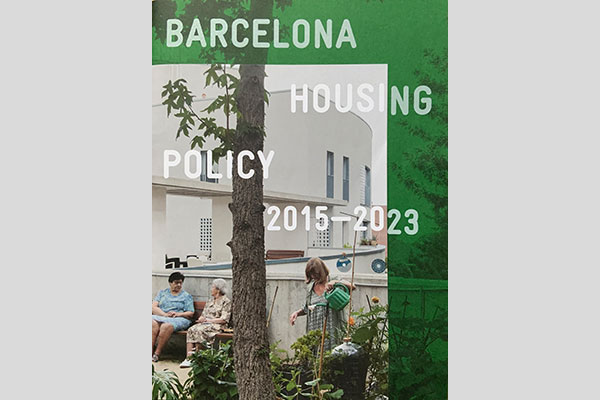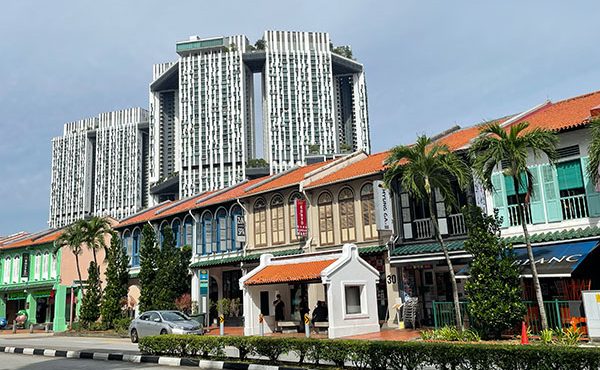
Our group of BC Planners felt a bit apprehensive as we approached the door of a plain, unremarkable building. We were warned that the right door was a little hard to find and we now understood why. It was one of many identical doors lining the frosted window street fronts of seemingly identical modernist slab buildings at the north edge of Barceloneta.
Despite the slight confusion, we were all excited. We had come to hear Eduard Cabré Romans, Housing Policy and Urban Planning Consultant at Barcelona City Council & Girona City Council. He had generously agreed to present to our group. The topic? Housing affordability. Specifically how Barcelona, a city known for its progressive housing policies, is tackling this challenge.
Although Eduard was kind enough to tell us he had prepared a 66-slide presentation before we left Vancouver, nothing prepared us for the depth of his talk—a detailed and open presentation that lasted two and a half hours.
There were many audible gasps from our group and countless questions as Eduard walked us through the complex system Barcelona has developed to address their housing challenges. While their challenges mirror those of Vancouver, the solutions were strikingly different, particularly at the foundational level.
Eduard explained these foundational principles by referring to the Barcelona Housing Policy 2015-2023, a comprehensive initiative aimed at addressing the city’s housing crisis with a focus on affordability, quality, and inclusivity. Unfortunately, this document isn’t available online, but much of the same content is covered in this Housing document which we’ll link to as we continue this series. This initiative is closely tied to the Right to Housing Plan 2016-2025 spearheaded by the Colau administration and shows the progress of its implementation.
For BC planners and municipal officials, two foundational insights from the Barcelona Housing Policy 2015-2023 are worth quoting off the bat, as meaningful counterpoints to local wisdom:
“On its own increasing the quantity of housing is not sufficient to reverse the trend of rising costs of homes…increasing supply does not reduce prices in the free market. To achieve that, more diversity is needed with respect to the income levels targeted by the rental market and the types of tenancy regimes available.”
Next:
“Increasing stock of permanently affordable housing required providing provisions by the public sector, both directly and in partnership with other actors. It also involves making the private sector responsible for providing affordable housing.”
We will unpack what this means over the next coming articles since its implications are far-reaching. But to be clear, in Barcelona, housing is treated as a public service, akin to education or healthcare. As such, it requires extremely careful planning and management. This stands in stark contrast to Vancouver—and North American cities, broadly—which rely on market forces and “increasing supply” to deliver affordable housing. If Barcelona’s successes are an indication, this fundamental difference is a root cause of ongoing issues in Vancouver and many other North American cities facing the same affordability challenges.
But, I’m getting ahead of myself…let’s start with a general overview of the Barcelona Housing Policy 2015-2023.
This 53-page document, though compact, is highly comprehensive. It’s divided into four large sections—Historical Overview, Building A New Housing Policy, Measures Taken 2015-2023, and Remaining Challenges. The bulk of the document focuses on the measures taken, which are broken down into Supply, Stability, Subsidy, Social Dialogue and Sustainability. In this series, we’ll summarize some of the most important ideas from these sections with a focus on supply, since it is such an important and debated issue locally.
A broad overview is essential to understanding the depth of this policy. The Policy focused on building new public housing, promoting social housing, and rehabilitating existing buildings to improve living conditions while maintaining affordability. Incentive programs encouraged the return of vacant units to the market.
Another key element was regulating the rental market. The city advocated for rent control measures and tenant protection regulations to prevent excessive rent increases and speculative practices. Efforts were also made to promote stable, long-term rental agreements to provide tenants with greater security.
To prevent evictions and ensure housing stability, Barcelona provided legal and financial assistance to residents facing eviction or at risk of homelessness. Programs were specifically created to support vulnerable groups—low-income families, the elderly, and individuals with disabilities—ensuring they had access to stable housing. Emergency rental vouchers helped tenants manage arrears and avoid eviction.
The Policy also promoted sustainable urban development through mixed-use projects integrating housing with community amenities. Energy-efficient and eco-friendly building practices were prioritized in affordable housing developments. To encourage social inclusion and foster diverse neighbourhoods, affordable housing units were intentionally distributed across the city.
Community participation was a core principle, with residents and stakeholders involved in decisions related to housing development and urban planning.
Finally, innovative financing and partnerships were explored to fund housing projects, including public-private partnerships, leveraging additional resources. Collaborations with local and international organizations introduced innovative solutions and best practices in housing policy.
The result?
Between 2016 and 2023, Barcelona’s affordable housing provided housing for an additional 15,700 people, over and above its previously existing affordable housing stock. 52% of these were from new construction while 48% came from acquisitions and private units temporarily mobilized as affordable housing. Within this context, 75% of the new affordable housing was provided by the City Council, with 1,551 housing units bought between 2015-2023 with an investment of 165 M€.
Our chronicling journey will continue to delve deeper into Barcelona’s housing policies and practices, but like with any strong regulation, we need some clarity on the criteria of “affordable housing” and “social housing”…
***
Other pieces in The Barcelona Chronicles:
- Part 1 – Introduction
- Part 2 – Cerdà and Colau: Two Key Figures
- Part 4 – Defining Affordable & Social Housing
- Part 5 – Supplying Affordable Housing
- Part 6 – The 30% Measure and Others
- Part 7 – Vancouver v. Barcelona – Foundations
- Part 8 – Barcelona v. Vancouver – Strategies
- Part 9 – The Eixample and the Superilla
- Part 10 – The Superilla Pilot
- Part 11 – The Superilla…Evolved
- Part 12 – Vancouver v. Barcelona – Urban Design
- Part 13 – Reflections on Two Cities
***
Erick Villagomez is the Editor-in-Chief at Spacing Vancouver and teaches at UBC’s School of Community and Regional Planning. He is also the author of The Laws of Settlements: 54 Laws Underlying Settlements Across Scale and Culture.





3 comments
I always find it a bit funny that local planners often look abroad for policy ideas, when there are cities closer to home that outperform many European ones. Edmonton, Chicago, and Spokane, for example, surpass any European city when it comes to housing affordability. Their secret? Build housing and avoid getting bogged down in debates about the ‘right’ type of housing
Thanks for your comment. Local planners actually rarely ever look deeply into policies abroad. Which is why the Field School came into being. It’s a very insular discipline and that is why the solutions across North America are largely based on the the same premises, including Edmonton, Chicago and Spokane. More specifically that market-based supply is THE answer. Unfortunately, the issue is much more complex and history has already proven that assumption wrong. Supply and building more housing is important, but only one of many variable. Sadly, one needs to move outside the North American context to understand why and learn how they other cities have negotiated the issues. It’s a global problem and we run the risk of arrogantly believing that we know the answers locally when, in fact, we are simply exacerbating the issues.
The book offers insights into future housing strategies, considering the implications of climate change, changing demographics, and economic uncertainties. It emphasizes the need for sustainable and inclusive policies that prioritize the needs of all residents. Overall, this third part of “The Barcelona Chronicles” serves as an essential resource for understanding the complexities of housing policy in one of Europe’s most dynamic cities, reflecting broader trends in urban development and social justice